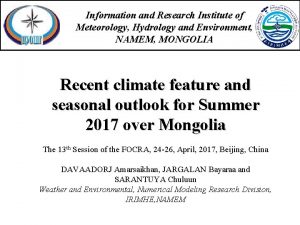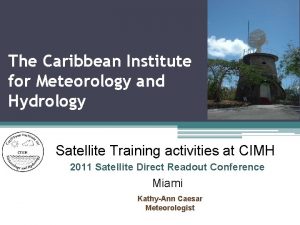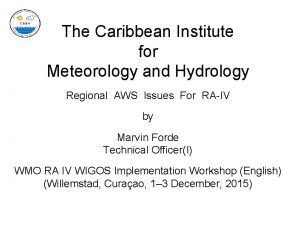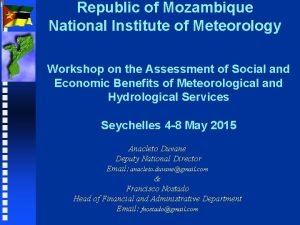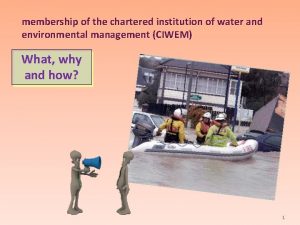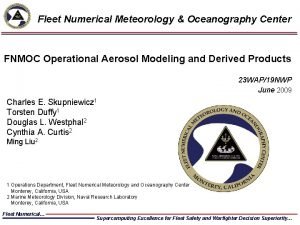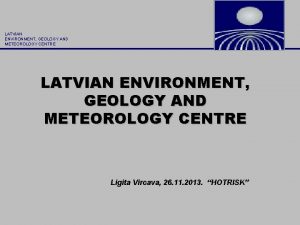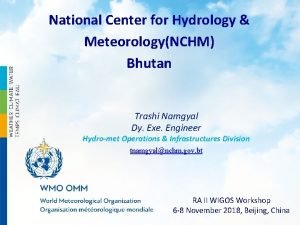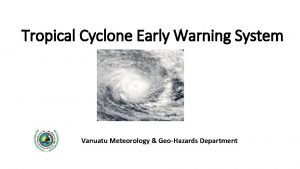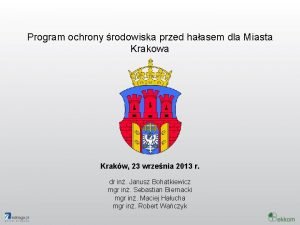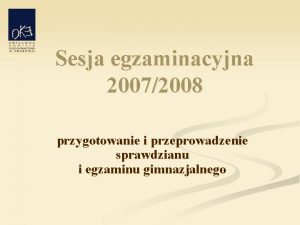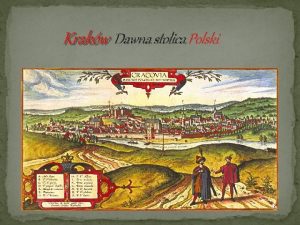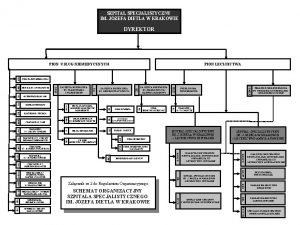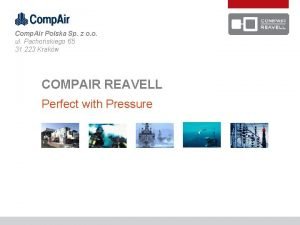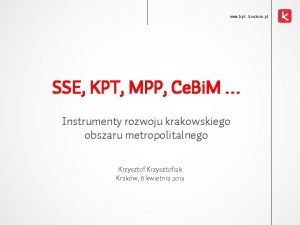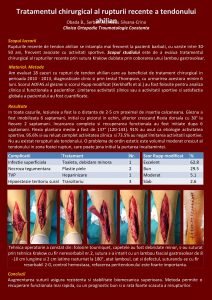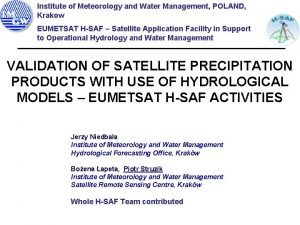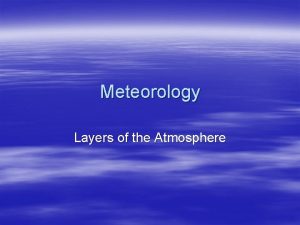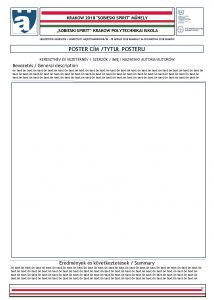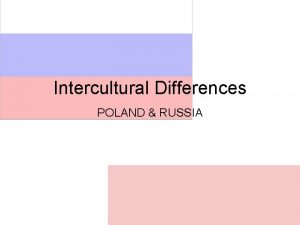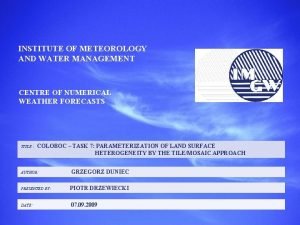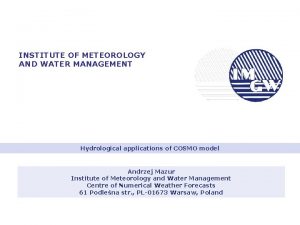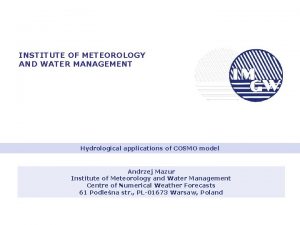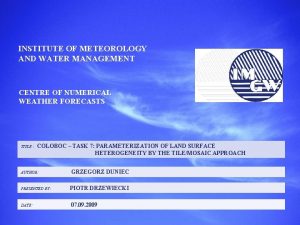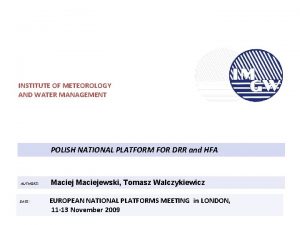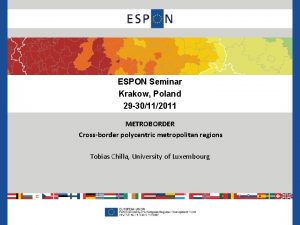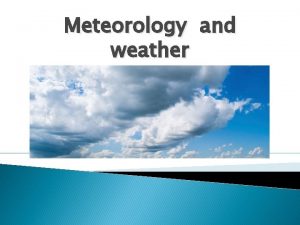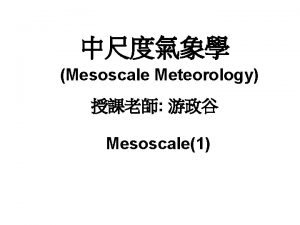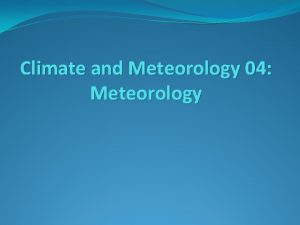Institute of Meteorology and Water Management POLAND Krakow






























- Slides: 30

Institute of Meteorology and Water Management, POLAND, Krakow EUMETSAT H-SAF – Satellite Application Facility in Support to Operational Hydrology and Water Management VALIDATION OF SATELLITE PRECIPITATION PRODUCTS WITH USE OF HYDROLOGICAL MODELS – EUMETSAT H-SAF ACTIVITIES Jerzy Niedbała Institute of Meteorology and Water Management Hydrological Forecasting Office Jan Sadoń Institute of Meteorology and Water Management Piotr Struzik Institute of Meteorology and Water Management Satellite Research Department Whole H-SAF Team contributed

Presentation outline: 1. EUMETSAT SAFs – already presented by Thomas Heinemann. 2. H-SAF overview – already presented by Bizzaro Bizzari. Remained: 3. IMWM Poland - data sources for hydrological models. 4. Hydrological cycle and information needed for modelling of processes. 5. Hydrological models, thier requirements and possible use of satellite data – outcome of H-SAF (Cluster 4) activities. 6. H-SAF Validation programme (precipitation products): - Conventional validation, - Hydrological impact studies. 7. Solving the problem of spatial and temporal resolution. 8. Conclusions

Institute of Meteorology and Water Management, Kraków, Poland Hydrological Forecasting Office Satellite Research Department EUMETSAT Satellite Application Facility in Support to Operational Hydrology and Water Management (H-SAF) Activities: • Operational hydrology – forecasting and warning • Operational receiving, processing and distribution of satellite products to the users in IMWM network. • Research and implementation of satellite products in meteorology, hydrology, agrometeorology… • H-SAF activities officially started (15 Sept. 2005) – development phase 20052010, 12 European countries involved. Poland coordinates Hydrological Validation and implementation cluster.

Lightning detection SAFIR METEOSAT (7, 8, 9) NOAA (all) Feng. Yun 1 D Ready for Metop 60 Synop 152 Climate 978 Raingauges NWP: LM-COSMO, ALADIN IMWM 196 Snow obs. posts Poland 8 radars Fig. 28 - Composite image from all Polish radars. 989 telemetric posts

Operational Hydrology and modelling Main activities of operational hydrology is closely related with use of forecasting hydrological models, which convert meteorological inputs, hydrological inputs and parameters characterising cachment to discharges in streams and rivers. Use of such a models is also part of flood warning systems, which determine risk of flood according to forecasted hydrograms. Generally most of hydrological models are deterministic, based on physical equations describing water fluxes and energy exchange. Many models used in operational practise are still conceptual, semiempirical or empirical. Well-designed, distributed network that measure temperature, precipitation (rainfall and snowfall), snowpack, soil moisture, vegetation properties, radiation, wind, evaporative flux and humidity contribute to the quality of hydrological forecasts.

Hydrological processes are frequently rapid and dangerous Development of flash flood as a result of severe storm (Switzerland)

Proper information and warning is highly required Well informed people do not panic even in extreme conditions

Development in operational hydrology and resulted demands for better input data • Classic hydrological models have been optimised for use with point observations (such as precipitation and streamflow) and were inadequate for extension to data assimilation, which is distributed in space. • We observe consequent exchange of hydrological models used operationally from models, which can accept only point data to the models based on gridded information. • An improved higher resolution of observed data will decrease the uncertainty of hydrological model predictions. • Remote sensing data should bring new type of information (both qualitative and quantitative) accepted by hydrological models.

Space structure of model levels. Preprocessing of data is required to fit input variables to model resolution. - grid based A model structure based on regular fine grids, matching the resolution of the other spatial data, is much to be preferred. -based on HRU’s (Hydrological Response Units) Data are spatially aggregated giving mean values for Hydrological Responce Units (HRU). -lumped subcatchment is another alternative frequently used in operational hydrology. Different scales of data processing in typical levels of hydrological model Satellite information (depending of instrument used) has frequently not adequate spatial and temporal resolutions – down/up scaling and merging with other data sources is required

ies tud ts c pa Im Hydrological cycle vs. satellite products

EUMETSAT Satellite Application Facility in Support to Operational Hydrology and Water Management (H-SAF) H-SAF bottom-up aproach Requirements driven by operational hydrology needs. Creation of operational satellite products for: -Better spatialisation of conventional measurements, -To complement ground observations on the areas with sparse ground networks and/or not covered by radars, - Merging satellite products with other data sources, - Redundancy of information - useful in case of disaster situation (damage of measuring posts or data links) Final assessment of satellite products to be done by Hydrological Impact Studies. Demonstration and training on satellite products use, in real operational environment of State Hydrological Services

Logic of the incremental development scheme Augmented databases Current instrumen ts Initial database s Cal/val programme Baseline algorith ms Prototypin g Version-1 New instruments Advanced algorithms Version-2 Final Version 2007 Inter Consortium beta product delivering Operational End-users and Hydrological End-user feedback validation programme

H-SAF activities on satellite products validation Cluster 1 Cluster 2 Cluster 3 Precipitation products Soil Moisture products Snow products Classical Validation. Comparison to ground measurements. Hydrological impact studies Belgium Germany Hungary Italy Poland Slovakia Turkey Austria France ECMWF Finland Germany Poland Turkey Romania Belgium, France, Germany, Italy, Poland, Slovakia, Turkey At least 24 catchments, 14 operational models

The purpose of hydrological validation plan • to establish the plans of the hydrological institutes for performing the impact studies soon after start of the regular products distribution. • The objective of the Hydrological validation programme is to independently assess the benefit of the novel satellite-derived data on practical hydrological applications.

Elements of hydrological validation plan • elaboration of the requirements (i. e. , what is needed to perform the impact studies), • selection and/or development of the algorithm/modelling tools to perform the impact studies, • describtion of the test sites, their equipment and the experiment planned to be carried out, • Performance of the impact studies on the base of all test sites using all available satellite data, • structure of the Education and Training (E&T) activities.

Structure of the WP-5000 (Hydrovalidation) WP -5000 Hydrological validation Poland (IM WM) WP-5100 Products training Poland + Several WP-5200 Developments Poland + Several WP-5300 Impact study 1 Belgium WP-5400 Impact study 2 France WP-5500 Impact study 3 Germany WP-5600 Impact study 4 Italy WP-5110 Soil moisture Austria WP-5210 Development Belgium WP- 531 Scheldt 0 river WP-5410 Grand/Petit Morin WP-5510 Sieg catchment WP-5610 Tanaro river WP-5120 Snow Finland WP-5220 Development France WP-5320 Meuse river WP-5420 Beauce region WP-5520 Ammer catchment WP-5620 Arno river WP-5130 Precipitation Italy WP-5230 Development Germany WP-5700 Impact study 5 Poland WP-5430 Adour. Garonne basin WP-5530 Dill catchment WP-5630 Basento river WP-5240 Development Italy WP-5710 Sola river WP-5800 Impact study 6 Slovakia WP-5250 Development Poland WP-5720 Skawa river WP-5820 Nitra river WP-5260 Development Slovakia WP-5730 Prosna river WP-5830 Kysuca river WP-5920 Manavgat WP-5930 Upper Euphrates WP-5270 Development Turkey WP-5840 Hronriver WP-5850 Topla river WP-5940 Upper. Karasu WP-5950 Kırkgöze basin WP-5810 Myjava river WP-5900 Impact study 7 Turkey WP-5910 Sakarya river

Catchment characteristics Climatological criterion - classifies rivers depending on the climatological zone the river is located in. Within area covered by EUMETSAT member and cooperating states, three major zones can be distinguished: warm temperate zone (subzones: Mediterranean and marine), cold temperate zone (subzones: continental and subpolar) and mountainous zone, Geographical and high-altitude criterion – describes localization of the river including location in a specific geographical environment. According to this criterion rivers are categorized as for example mountainous rivers, littoral rivers, etc. , Catchment management criterion – allows to group the rivers, or more precisely their catchments, regarding predominate spatial management type. (e. g. urban, agricultural or sylvan catchments, etc. ), Catchment size criterion – classifies river systems taking into account the total area of their catchments.

Hydrological regimes Pluvial, oceanic – occurs in temperate climate. Distribution of precipitation is homogeneous throughout the whole year. The annual river flow is high. In the summer time, due to evaporation, water level in rivers is lower comparing to the winter. Western Europe rivers Pluvial, Mediterranean – maximum water level appears in winter, because of the strongest recharge. Rivers can periodically or even totally dry up in summer. Rivers in Mediterranean Countries Nival – the rivers are frozen through the most part of the year. The highest flows appear in spring due to snowmelt. Minimum water levels are observed in autumn and winter. Rivers in Eastern Europe and Scandinavia, Pluvio-nival – two periods of high water levels are observed: the first in spring, caused by the snow cover melting as well as rainfalls and the second one in summer, caused by rainfalls Rivers in Eastern and partly Central Europe Glacial – the rivers have their headwaters in the glaciated area. Maximum water flows are observed in summer Central Europe rivers.

Operational hydrological models and selected testbeds Belgium: SCHEME grid cell conceptual model, 2 test sites Scheldt, Meuse France: SAFRAN-ISBA-MODCOU set of models, 3 test sites Grand/ Petit Morin, Beauce, Adour-Garonne, Germany: PRMS, HBV-Bf. G, MMS/MHMS models, 3 test sites Sieg river, Italy: ARTU’, NASH, DRi. FT models, 3 test sites Arno, Basento, Tanaro rivers, Poland: SH system (SMA, conceptual), 3 test sites Soła, Skawa, Prosna, Slovakia: MIKE 11 -NAM, Hron rainfall-runoff, 5 test sites Myjava, Kysuca, Nitra, Hron, Topľa, Turkey: Snowmelt Runoff Model SRM, HBV models, 5 test sites Upper Euphrates, Upper Karasu, Kırkgöze , Manavgat, Sakarya, Finland: to be defined.

Test catchments location ? • 7 (8) countries • 24 test sites • Variety of climatological conditions • Variety of terrain conditions • Variety of land cover • Different hydrological regimes • Catchment size: 242 – 102000 km 2 • 902 raingauges, 21 radars

Input data for hydrological models (analysis performed by H-SAF Cluster 4) PARAMETER REQUIRED SPATIAL RESOLUTION REQUIRED TEMPORAL RESOLUTION Precipitation Regular grid 50 m, 100 m, 500 m, 1 km, 7 km, 8 km HRU, subcatchment 10 min, 15 min, 1 h, 3 h, 6 h, daily Snowfall Regular grid 1 km, 8 km, HRU 6 h - daily Air temperature 8 km, 25 km, point, HRU 10 min, 15 min, 1 h, 2 h, daily Soil moisture point, catchment daily Snow covered area 50 m, catchment daily Solar radiation 8 km, 50 km, point 15 min, 1 h, 6 h, daily Snow water equivalent 50 m, catchment daily Long wave radiation 8 km 1 h Sun duration 50 km 6 h Land use, vegetation type 30 m, 250 m, 1 km 10 days, season Wind speed 7 km, 8 km, 25 km 10 min, 1 h, 2 h Humidity 8 km, 50 km, point 1 h, 2 h, 6 h

Lesson learnt • The analysis of the questionnaires from the hydrological modellers do not allow to common definition of the parameters expected from the satellite products at this point. • It is necessary to analyse the available (now or in near future) SAF’s products that could be useful for application in hydrological models inter-SAF activities. • Large variety of models regarding spatial domain – from detailed grids (100 -500 m), through HRU based model to catchment based models, • Large variety of requirements regarding temporal domain – from detailed 10 -15 min data to daily means, • Most important inputs: precipitation (including snow), temperature, radiation components (mainly solar). • Less frequently used parameters: detailed radiation budget (short/long wave), evapotranspiration, vegetation type and actual status. • Data needed (lack of adequate ground measurements), expected from satellite information: soil moisture, snow water content. • We predict constant grow of user requirements during H-SAF development phase due to modernisation of measuring tools and models themselves.

General hydrological validation algorithm (1) Preparation of tool verification - the hydrological model simulated mode - calibration and the verification of hydrological model input data for hydrological models from manual and automatic ground stations and experimental resarch hydrological model output from hydrological model (simulated hydrograph) • average square error • average square relative error • maximum relative error • time relative error comparing simulated and observed hydrographs

input data for hydrological models from radar system (now-casting) and meteorological model (forecasting) Hydrological model in operating mode (2) General hydrological validation algorithm operating mode - starting hydrological model in operating mode input data for hydrological models from manul and automatic ground stations and experimental resarch hydrological model output from hydrological model (forecasted hydrograph) • average square error • average square relative error • maximum relative error • time relative error comparing forecasting and observed hydrographs in nonoperating time

input data for hydrological models from radar system (nowcasting) and meteorological model (forecasting) rainfall and snow satellite data General hydrological validation algorithm (3) Hydrological model in operating mode using satellite data operating mode - starting hydrological model in operating mode input data for hydrological models from manul and automatic ground stations and experimental resarch hydrological model output from hydrological model (standard forecasted hydrograph and forecasted hydrograph computed using satellite data) • average square error • average square relative error • maximum relative error • time relative error soil moisture temperature, rainfall and snow comparing two forecasted hydrographs (computed on base standard or satellite data) with observed hydrograph in nonoperating time

General hydrological validation algorithm (4) Hydrological validation plan criteria of choice comparing two forecasting hydrographs (computed on base of standard or satellite data) with observed hydrograph in nonoperating time use of the satellite data increases the quality of hydrological forecasting statistical analyses YES • average square error • average square relative error • maximum relative error • time relative error NEITHER „YES” NOR „NO” we recommend satellite data as an input to hydrological forecasting model NO we recommend standard data as an input to hydrological forecasting model Further research must be done: when, where and why use of satellite data gives negative results. Satellite data could be used in case when other data are not available Feedback to Clusters 1, 2, 3

Solving the problems with spatial and temporal resolution (satellite products bias ? ). 1. H-SAF additional tasks: - up/down scaling methods and algorithms, - Merging sateliite products with ground observations, - Adapting satellite products to hydrological models inputs (interfaces). 2. Tools included in hydrological models (also considered): - Data processors, - Embedded GIS tools.

Preprocessing Tasks l. Temporal domain - to reach the calculation time step of the hydrological model l Temporal disaggregation of measurements l. Spatial domain – data regionalisation/scaling l Spatial interpolation of data (measured or forecasted) to a reference grid or center points of HRUs l Vertical dependence of parameters to be taken into account l Filling of data gaps

Preprocessor: Precipitation Observed Station Data Forecasted Grid Data Temporal. Disaggregation Temporal Spatial. Interpolation Spatial (from. Stationtoto. Reference. Grid) (from Spatial. Interpolation Spatial (from. NWPGridtoto. Reference. Grid) (from Spatial. Aggregation Spatial from. Reference. Gridtoto. HRU HRU from Observed station data transformed into mean HRU values Forecasted grid data transformed into mean HRU values Satellite data are available in defined time slots (variable for polar sat. ) and not in regular grid (resolution depend on viewing angle)

Conclusions: 1. H-SAF is preparing operational structure for hydrology. Without acceptation of products and their quality (at least among EUMETSAT Member and Cooperationg States), this activity will be useless. 2. Operational structure must include not only products creation but also creation of communication links to the users (GTN-H, WIS ? ). 3. Strong need for closer links between satellite data providers and hydrological users – H-SAF consortium cosists of both. 4. We do not forsee to re-invent the wheel – large part of activities based on well known and partially tested algorithms and methods. Hydrological component of H-SAF useful not only for internal purposes. 5. First H-SAF products already available – soil moisture.
 Water and water and water water
Water and water and water water Meteorology hydrology and water management
Meteorology hydrology and water management Caribbean weather satellite
Caribbean weather satellite Caribbean institute for meteorology and hydrology
Caribbean institute for meteorology and hydrology Mozambique national institute of meteorology
Mozambique national institute of meteorology Chartered institute of water environment management
Chartered institute of water environment management Nokia solutions and networks kraków
Nokia solutions and networks kraków Fnmoc
Fnmoc Latvian environment, geology and meteorology centre
Latvian environment, geology and meteorology centre Nchm bhutan
Nchm bhutan Vanuatu meteo cyclone warning
Vanuatu meteo cyclone warning German aggression september 1938
German aggression september 1938 Prc.krakow
Prc.krakow Biblioteka wojewódzka kraków
Biblioteka wojewódzka kraków Mapa hałasu kraków
Mapa hałasu kraków Wciągnięte brodawki kraków
Wciągnięte brodawki kraków Inicjatywa mikro kraków
Inicjatywa mikro kraków Pensjonat u pana cogito
Pensjonat u pana cogito Federal benefits unit
Federal benefits unit Prc.krakow.pl
Prc.krakow.pl Oke kraków obieg
Oke kraków obieg Kraków dawna stolica polski
Kraków dawna stolica polski Prc.krakow.pl
Prc.krakow.pl Rda.krakow.pl
Rda.krakow.pl Zse2 krakow
Zse2 krakow Szpital specjalistyczny im. józefa dietla kraków
Szpital specjalistyczny im. józefa dietla kraków Prc.krakow.pl
Prc.krakow.pl Compair polska
Compair polska Mpp kraków
Mpp kraków Sutura krakow
Sutura krakow Wahadło foucaulta kraków
Wahadło foucaulta kraków

